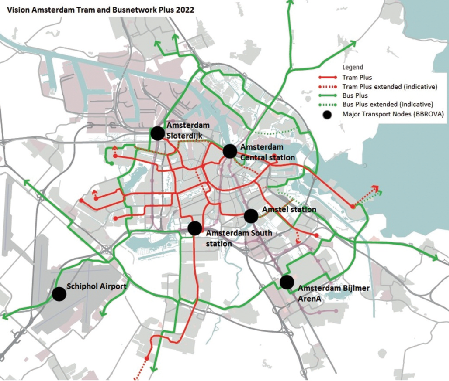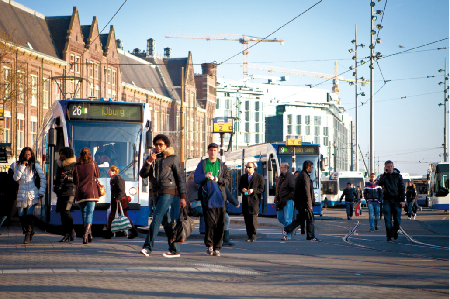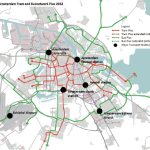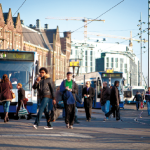Bringing more travellers in tram, bus and metro to their destination
faster is the joint ambition of Stadsregio Amsterdam and
municipal transport company GVB. Moreover, this can be done
with much less funding. With the transport plan 2014 ‘Towards
better public transport’ adopted by the executive committee of
the Amsterdam City Region the has undertaken it’s first concrete
steps towards an improved network. Until 2024 incumbent GVB
expects to make the Amsterdam public transport at least 10%
safer, more than 20% faster, whilst attracting thereby a third
more passengers. Ridership is expected to rise from 740.000
users in 2012 to somewhat less than one million in 2020. GVB
envisages at least 40% less dependence on subsidy for operations
in this period .
The Amsterdam urban transport contract is expected to be
awarded in Autumn this year to the GVB until 2024. Stadsregio
will make use of a new provision in Dutch law on the direct
award to an inhouse operator, complying with the PSORegulation
(COM 1370/2007) of the Commission.
Public transport in Amsterdam has to do with considerably less
operating costs from 150 million in 2011 to around 50 million
in 2024. But by making smart choices, the quality of public
transport even goes up. GVB does so by responding to the
changing mobility flows, to shorten a network to provide clear,
dynamic travel information and by simply optimize the supply of
service focused on where their users are concentrated to where
they want to travel at shortened travel time. It also aims to
improve social safety.
More high-frequency lines: shorter travel times
Public transport is not only available to all travellers, Amsterdam
dwellers, occasional users and short stays (tourists), but also for
students and commuters. Through new timetable concepts
commuters and students should be brought faster to their destination,
offering a easy and reliable transfer at one of the six
main public transport nodes on the metro/railway ring: Schiphol
International Airport, Amsterdam South station, Central station,
Amstel station, Bijlmer-ArenA station and Sloterdijk-station.

The high-frequency metro is and will remain the backbone of
the public transport, notably even stronger after the opening of
the North / South metroline (foreseen December 2017). Trams
and buses should be given a better connection to the various
subway lines that offer higher frequencies.

The current “spaghetti network” of the Amsterdam public
transport is dense, winds through the city and has relatively low
frequencies. Today’s regular traveller values more and more a
high frequency. One reliable transfer on their trip is more or less
accepted by regular users, provided the frequency of the service
is high and therefore there are only short intervals to the connecting
service.
As of 2014 public transport is going to focus on significant numbers
of users. The focus shifts from a guaranteed offer of weak
lines to corridors with particularly heavy ridership. Some of the
least frequently used tramlines as well as bus routes will be curtailed
or could eventually disappear all together.
To guarantee a large group of users more to travel to their destinations
quicker, some 25 rarely used network stops (of a total
of 1900 stops) will be eliminated in 2014. For the 3000 people who use these stops daily, an alternative stop will be offered at
a distance to maximum of 400 meters. In contrast, 80.000
people will be arriving faster at their envisaged destination.
The metro will eventually offer higher frequencies and does so in
2014 by as a first step by increase the frequencies on Saturday
and Sunday mornings.
Investments to drive high frequency
The Amsterdam City Region will in the period 2014-2025 make
around a 600 million Euro additional investment in the infrastructure
for improving the quality of urban public transport
infrastructure. Much of it will be spend in and around
Amsterdam.
These investments include modifications to the infrastructure
and free flow measures, such as more free bus ways and tram
lanes and also the removal and installing of unprofitable stops
and stations. With the current/existing plans, the total investments
will amount to 1.2 billion euros.
The Regional Council of the City Region Amsterdam sets the
minimum general outlines of the network system, such as the
number of users to be serviced, the quality of transport supply
and social security. The board of the Amsterdam City Region
then will award a contract to an operator that delivers these output
corresponding with the level of the available budget. The
public transport company determines how within the framework
and within budget it can best deliver an integrated network
performance.
Contact: Douwe Tiemersma
More Information

